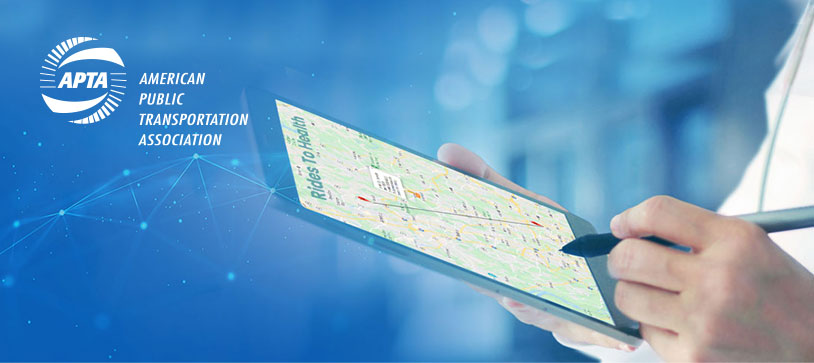
Sep 04 RIDES TO HEALTH
Dr. Bryce Kositz, IT Curves
bkositz@itcurves.net
Connecting Dots In Healthcare Transportation
Introduction
Access to transportation is a key social determinant of health, particularly for those suffering from kidney disease, who require three round trips a week to their life-sustaining dialysis treatments. Dialysis care, where time is critical for the patient, poses a significant and unique problem for transportation providers since more than an estimated 50% of all dialysis patients depend on public transit. The demand for transportation to dialysis centers burdens ADA paratransit schedules and budgets, and the patients themselves often receive inadequate or incomplete treatment because of transportation failings. More than just affecting transportation agencies and patients, unreliable transportation also hurts the operations and quality of service of dialysis centers. Failures in transportation similarly harm the entire healthcare network and its funding sources by pushing more patients into ambulances and emergency rooms, costing the system more money while providing lower quality of care.
Rides to Health is a new service paradigm that links each part of the customer and provider experience in an integrated system, increasing the quality of care and benefitting every party involved. It is a specialized brokerage service, technology, and provider network which solves many of these issues by connecting the dots between dialysis centers, funding sources, transportation providers, and patients themselves. Rides to Health provides each a set of tools to help manage transportation to and from dialysis centers, significantly improving outcomes for all parties.
This short article will cover the problems, consider the lessons from prior pilots, and finally discuss the specific methods Rides to Health uses to build upon the lessons to address the issues. Developing a unified system to connect the dots with Rides to Health solves a thorny problem for paratransit providers, dialysis centers, funding sources, and above all patients. This integrated network is not limited to dialysis centers and can further be applied to improve access to all sorts of preventative healthcare, leading to lower costs and greater quality of service.
The Problem
Beyond the clearly vital health problems faced by dialysis patients, their need for reliable transportation produces problems for the patients, paratransit providers, funding sources, and dialysis centers.
More than 700,000 people in the US suffer from End Stage Renal Disease (ESRD) [1] meaning total failure of their kidneys. The only treatments for this affliction are either a kidney transplant or dialysis. The dialysis procedure effectively does the job of the kidney, but patients must come in three times a week for three to five hours a session. Already in a weakened state, particularly after the dialysis procedure, patients largely rely on public transit, friends, or family to take their six rides a week to and from their dialysis center. As seen in Figure 1, only a quarter of patients are able to drive themselves, with another 20% depending on friends and family, leaving the majority of dialysis patients reliant on other providers, including public paratransit and private providers [2] .
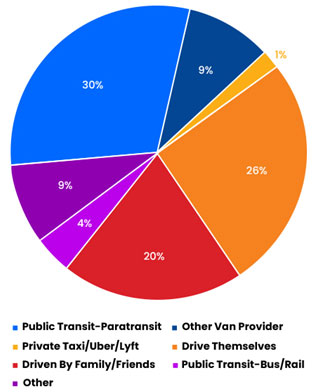
Patients dependent on paratransit – which offers non-guaranteed pick-up windows rather than specific arrival and departure times – may arrive late or feel forced to leave the appointment before the course of dialysis is completed lest they miss their ride. Given the required 24-hour booking headway for most paratransit providers, changing their reservation may not be possible if a patient misses their ride. Any delay in treatment can cause significant harm to the patient and an impaired quality of life. Those who arrive late may have to cut their treatment short; similarly, leaving early to catch a ride can cut treatment short. Finally, even if everything goes right on the transportation side, patients may simply not be healthy enough for immediate transportation after the end of their dialysis treatment. Paratransit schedules are generally not agile enough to respond to the needs of dialysis patients. For all these reasons, dialysis transportation poses a unique and large-scale problem for many public paratransit providers.
Studies show that 35% of transit agencies reported adverse impacts on their services because of the demand for dialysis trips, including expanding services and increasing budgetary pressure [3] . The most critical finding was that, during peak hours for dialysis, 25% of agencies reported that they suffered service constraints and had to cancel rides [4] Such failures to meet ADA mandates to serve all rides can result in costly audits. Even those paratransit providers handling the demand arising from dialysis still suffer issues in scheduling and routing when dialysis patients need to change their booking. Patients may also register complaints about paratransit services when rides to this lifesaving service arrive too late for the appointment.
As Figure 2 shows, dialysis takes up a significant share of transportation resources, compromising 17% of all healthcare transportation [5]. The trend stands to grow with time as the population ages, particularly considering proposals to drop non-emergency medical transportation from Medicaid coverage [6] . Such a change would cause the market to experience volatile changes that impact patient health and push more riders to already-overburdened services and lower quality healthcare. These trends have led to a massive increase in paratransit budgets; between 2000 and 2014, paratransit ridership and cost grew precipitously, as shown in Figure 3 [7] . The trend only stands to become more pronounced, potentially overwhelming public transit budgets uniformly throughout the US.
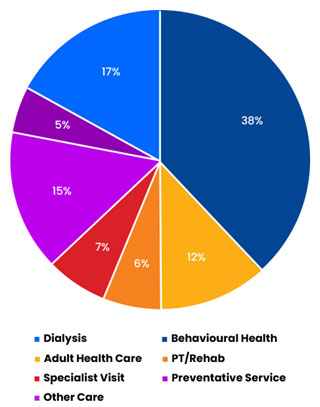
The story of dialysis transportation in Maryland, where IT Curves is currently piloting and developing Rides to Health, is a microcosm of that in the US. About 11,000 Marylanders attend dialysis centers [8] , meaning three round trips a week for 3.3 million trips per year. As of 2013, about 40% drive themselves or are driven by family or friends, 50% took public transit, and only 3% used other government agency transportation [9]. The cost of dialysis to public paratransit in Maryland is estimated between $30 and 40 million [10] or 15% to 20% of the entire paratransit budget for the state. This is on top of the $52 million which Maryland spent in 2019 on Medicaid Non Emergency Medical Transportation services that provided a fraction of trips compared to ADA paratransit [11] . Increasing funding for paratransit, however, has not been able to solve the problem posed by dialysis. It requires an innovative solution that connects the dots between parties, especially dialysis centers.

For dialysis centers, failures in transportation not only affect the health of their patients, but also limits its ability to serve patients effectively. There is also a direct correlation between the length of time dialysis patients spend in transportation and the likelihood of missing appointments. Total missed appointments across the US cost the healthcare sector an estimated $150 billion. For dialysis patients missed appointments can be life threatening [12] . Delayed arrivals similarly disrupt schedules for dialysis centers and lead to inefficiencies in the amount of care that can be provided. Workers at dialysis centers also report spending much of their time helping patients sort out problematic transportation [13] , further stretching center existing resources.
Finally, there is a lack of coordination among the sources of funding for transportation to dialysis that creates inefficiencies within the network. Public transportation agencies offering paratransit, Medicaid through the non-emergency medical transportation benefit, non-profit funders and transportation organizations, and private insurers offer varying levels of financial support for transportation to healthcare facilities. Rides to Health links these various systems, which allows for the unification of resources into one harmonized platform for more efficient operations, a better cost structure, and a better patient experience. Moreover, providing timely transportation to healthcare, particularly dialysis, drastically reduces emergency room use and other healthcare costs, thus saving the overall budgets for Medicaid and private insurers alike [14].
While recognizing the ADA mandate to not limit or prioritize any trip type, dialysis is a major cost for ADA paratransit that all parties suffer from. A unified platform linking patients, paratransit providers, dialysis centers, and funders would remove the problems of communication, lack of availability, and inconsistent timing. The system would thus decrease costs, increase responsiveness for riders, and provide better healthcare outcomes for patients [16] .
More than just integrating all parties onto a single platform and coordinating rides, Rides to Health also builds upon the lessons of prior pilots and studies which had aimed to solve the problem of dialysis and healthcare transportation.
Lessons from Prior Studies and Pilots
Many pilots have attempted to optimize the delivery of transportation to dialysis, improve health outcomes, and provide efficiencies for public transportation budgets. Rides to Health builds upon these lessons in providing its centralized brokerage and service.
First, pilots have attempted to assign patients more logically to appointments at their nearest facility [15] . This is a Medicaid requirement that private clinics frequently ignore since as clinics fill up, they will send new patients, rather than the geographically relevant ones, to other centers. Second, dialysis patients have regular schedules because the centers have regular shifts. Changing schedules to arrange patients into proximity groups – allowing of course for patient choice in scheduling – so that transportation can pick up more people in less time and fewer miles can drastically improve transportation times and cost. Similarly, as one van drops off a group, it can wait to pick up the next group, lessening stress for patients and the cost of deployment for transportation. Few programs have attempted to entirely rearrange dialysis schedules based on transportation, but initial results of similar projects show improved health outcomes for patients. Finally, and most importantly, providing dialysis centers with an operations module to view all trips can help them manage their cost of operations by allowing more predictability. When dialysis centers know that patients will be late, staff can then reschedule accordingly to keep each seat filled as much as possible. Experiments by Lyft and Uber show better outcomes for patients and more efficient use of facilities’ resources when dialysis centers help manage their patients’ rides [17] .
Each of these methods taken in isolation can aid to some small degree in helping dialysis patients access care in a safer, more efficient manner. Combining all three methods will drastically improve health outcomes, increase the cost-effectiveness of transportation solutions, and reduce hospital and state budgets by expanding access to dialysis, and even preventative care. Moreover, eliminating the worry over transportation can significantly decrease the stress and anxiety of dialysis patients, leading to better health outcomes. Rides to Health builds upon these lessons to provide a unified solution and centralized network that connects the dots between every party involved Rides to Health is an integrated transportation brokerage and ride-booking network for dialysis centers. Building on the lessons of prior pilots, Rides to Health links all four parties – patients, dialysis centers, funding sources, and of course transportation agencies – into an integrated network served by a central system and service platform to reap the benefits of coordination The system serves patients by providing more versatile and cost-effective options to riders to ensure they attend their appointments. By providing certainty with pick-up and dropoff times to appointments and flexibility for when they leave the dialysis center, no part of their treatment is abridged. The brokerage system also supplies patients with a greater choice of transportation providers as well as providing them with modern transportation services like vehicle tracking and an updating ETA for their trips. Integrated communication software sends timely calls, texts, or app notifications to riders to keep them informed of their trips and imminent pickup, meaning fewer forgotten and missed treatments.
Rides to Health Connects the Dots
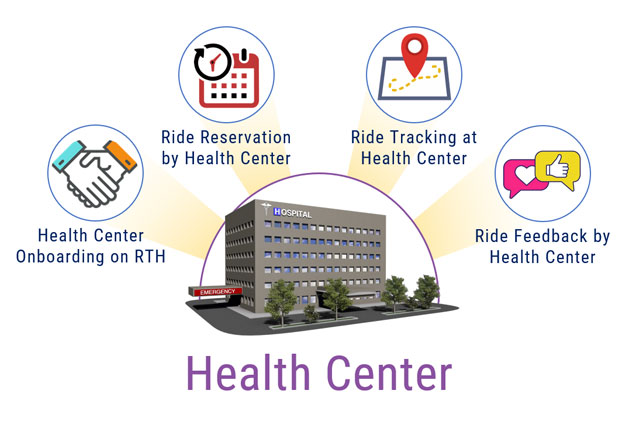
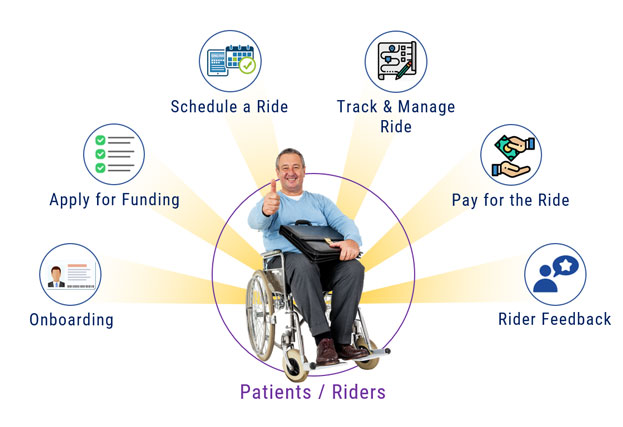
Rides to Health serves dialysis centers and heath care centers by providing an operations screen where they can monitor the ETA of incoming and outgoing rides which allows staff to reschedule dialysis machine seats as needed. By providing monitoring tools, we provide certainty about the arrival and departure of their patients, so center staff is freed up from assisting patients in finding a vehicle or talking with transit providers to find an appropriate ride home. The monitoring station also allows healthcare staff to change the ride schedules to meet the developing medical needs of the patient.
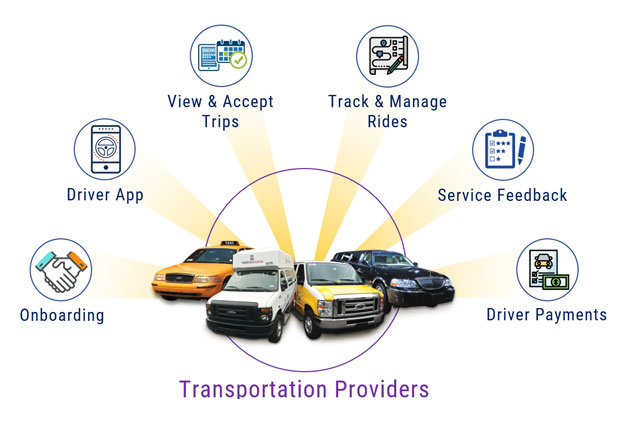
The Rides to Health platform serves funding sources by providing a unified platform to engage with those patients receiving transportation subsidies and streamline the payment system. The interface includes an extensive eligibility module that verifies patient and trip eligibility according to the rules set by each funding source. A central broker manages the services and allows multiple funding providers to collaborate and find maximal savings and accuracy. The detailed trip records created for each patient cataloging their rides to and from dialysis will also help funding sources reduce fraudulent transportation expenses.


Finally, Rides to Health reduces costs for transit and paratransit agencies by sending these time-sensitive and often-rebooked trips to more flexible, on-demand transportation providers. The specialized service will better meet the transportation needs of dialysis patients, remove these difficult-to-schedule trips from paratransit schedules, and lead to a much more efficient operation and better budget management for paratransit services.
Dialysis is a lifesaving treatment for a disease on the rise throughout the US. However, ESRD does not just affect the patient; their needs affect the communities around them. Rides to Health connects the dots through integration and communication to provide better transportation to this essential service, and thus provide better outcomes for every party along the way.
Refrences
[1] National Academies of Sciences, Engineering, and Medicine; Transit Cooperative Research Program [TCRP], Dialysis Transportation: The Intersection of Transportation and Healthcare (Washington DC; National Academies Press, 2019), 1.
[2] TCRP, Dialysis Transportation, 28.
[3] Ibid, 33.
[4] Ibid, 34.
[5] Ganuza, Adam and Rachel Davis, “Disruptive Innovation in Medicaid Non-Emergency Transportation,” Center for Health Care Strategies Brief, February 2017: 3
[6] Medicaid and CHIP Payment and Access Commission (MACPAC), “Medicaid Coverage of Non-Emergency Medical Transportation,” https://www.macpac.gov/wp-content/uploads/2019/05/Medicaid-Coverage-of-Non-Emergency-Medical-Transportation.pdf, May 2019.
[7] Kaufman, Sarah M. et. al., Intelligent Paratransit (NY: New York University Wagner, Rudin Center for Transportation Policy & Management, 2016), 4.
[8] KFH Group, Inc, Legislative Report J00H01.01: Study of Paratransit Services for Dialysis, Prepared for: Maryland Transit Administration and Maryland Department of Transportation, 31 October 2013.
[9] TCRP, Dialysis Transportation, 33; KFH Group, Study of Paratransit Services for Dialysis, 11.
[10] KFH Group, Study of Paratransit Services for Dialysis, 12.
[11] Maryland Department of Health, Report on the Maryland Medical Assistance Program’s Non-Emergency Medical Transportation (NEMT) Grant Program, 3 October 2019, 6: Transportation Research Board, State-by-State Profiles for Examining the Effects of Non-Emergency Medical Transportation Brokerages on Transportation Coordination (NP: April 2019), 46.
[12] Ray, Renee Autumn, The Role of Transportation in Improving America’s Health (Washington DC: Eno Center of Transportation, 2020), 5; TCRP, Dialysis Transportation, 43.
[13] TCRP, Dialysis Transportation, 31.
[14] National Academies of Sciences, Engineering, and Medicine, Cost Benefit Analysis of Providing Non-Emergency Medical Transportation (Washington DC: The National Academies Press, 2005).
[15] TCRP, Dialysis Transportation, 81.
[16] Ibid, 103, 107, 109.
[17] Health Research and Educational Trust, Social Determinants of Health Series: Transportation and the Role of Hospitals (Chicago: Health Research and Educational Trust, November 2017), 18.

